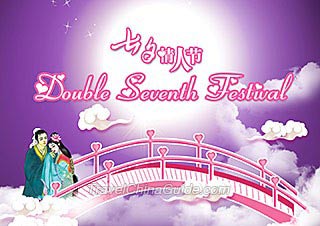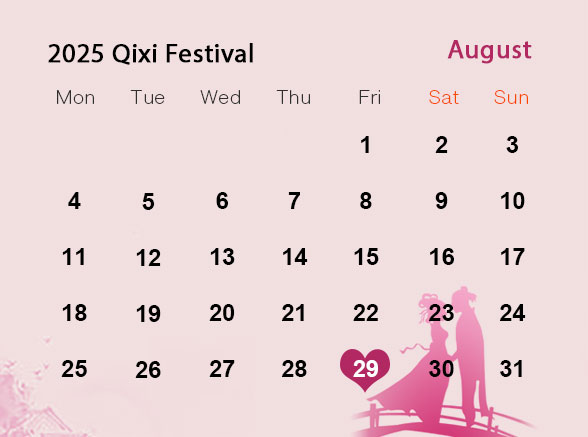Qixi Festival

| English: | Qixi Festival, Double Seventh Festival, Qiqiao Festival |
|---|---|
| Chinese: | 七夕节qī xī jié; 乞巧节 qǐ qiǎo jjié |
| Date: | Aug. 29, 2025; August 19, 2026 |
| Holiday: | No holiday |
| Observed by: | China, Japan, Korea, Vietnam and other Asian countries |
Falling on the 7th day of the 7th lunar month, the Qixi Festival, or Double Seventh Festival, is widely known as China Valentine's Day. It is a day full of romance because of an ancient household love story in China about Niulang and Zhinu (Cowherd and Weaver Girl).
China Valentine's Day
Young Girls' Festival (Qiqiao Festival)
When is Chinese Valentine's Day? Date of Qixi Festival 2024 - 2030
 |
Chinese Qixi Festival falls on the 7th day of the 7th lunar month, so the date on Gregorian calendar changes every year. There is no holiday for this festival. In 2025, it falls on August 29.
| Year | Date of Qixi Festival |
| 2025 | August 29, Friday |
| 2026 | August 19, Wednesday |
| 2027 | August 8, Sunday |
| 2028 | August 26, Saturday |
| 2029 | August 16, Thursday |
| 2030 | August 5, Monday |
Origin of Qixi Festival – Love Story of Niulang and Zhinu
In ancient Prehistoric Times (1.7 million years ago - the 21st century BC), Chinese already worshipped stars. Niulang, referring to Altair and Zhinu, the Vega, on two sides of the Milky Way catched their eyes. As the two meet each other once a year, their reunion day was worshipped as a special day.
In the Han Dynasty (202 BC - 220 AD), Zhinu the Vega was deified as a skillful weaver girl waving clouds, and at the same time patroness of females and kids. Hence, young girls prayed on 7th day of the 7th lunar month, considered as the birthday of Zhinu for skillful hands. By Song Dynasty (960 - 1279 AD), the custom of praying for ingenuity on 7th day of the 7th lunar month had been very popular and there were even specialized markets selling the stuff for the praying ceremony in the capital.
The most popular origin and love story of Chinese Qixi Festival is about Zhinu, the Weaver Girl and Niulang, the Cowherd. Their love was banned by Zhinu’s parents and Niulang was exiled to the earth. One day, when Zhinu came down to the earth for a bathing, the two met each other. Zhinu then decided to stay on the earth without permission, got married with Niulang and gave birth to two lovely kids. But happy time did not last long. Zhinu’s mother, Xiwangmu, or known as Heavenly Queen Mother got to know it and sent heavenly soldiers to take Zhinu back by force. Seeing it, Niulang carried their two kids and chased in a hurry. When Niulang was getting more and more closer, the Heavenly Queen Mother hurled her hairpin to create a river, the Milky Way, between them. Sorrowfully, Niulang and Zhinu cried from the bottom of their hearts. This moved magpies and they flew over to form a bridge over the river for the two to meet in the center. The Heavenly Queen Mother was also moved and allowed Niulang and their kids to stay in the heaven. But the family can only reunite once a year on the 7th day of the 7th lunar month with the help of magpies.
How to Celebrate Qixi Festival - Present-day Activities & Ancient Traditions
Presently, Chinese lovers and couples usually have a date on this Chinese lovers’ day and present gifts to each other. In recent years, more and more lovers choose to get married at a registry, or hold an ancient Chinese style wedding ceremony on that romantic day. The activities to pray for ingenuity are only inherited and popular in a small scale and young girls like to wear traditional Chinese costumes to attend them.
1. Worship the Moon & Appreciate the Stars
On that evening, girls would take a bath with water and sap, wear new clothes and worship the moon, as in ancient Chinese concept, moon was the auspicious sign for women. After, they would appreciate the Vega and Altair getting together, symbolizing the reunion of Zhinu and Niulang.
2. Pray to Zhinu for Skillful Hands
On 7th day of the 7th lunar month, the birthday of the Weaver Girl, women in ancient China would pray to her for skillful hands, which were considered to be the trait of a good wife. In some areas, they also prayed for intelligence, happy marriage, and conceiving a baby, etc.
3. Ingenuity Competitions
There were many different forms of competitions for ingenuity. Among them, threading multiple-hole needles was the most popular and the oldest dating to the Han Dynasty. Young girls would thread needles with five, seven or even nine holes. The one finished the threading fastest would win. Since Northern and Southern Dynasties (420 - 589 AD), young girls would catch a spider on the festival day and kept them overnight. In the next morning, the better the web, the handier the owner was predicted to be. In Ming and Qing Dynasties (1368 – 1911 AD), girls would mix river water and well water on the festival, then put needles gently on the surface of the water on the second day. If the shadow of the needle was in other shape instead of straight, it implies the girl had successfully obtained ingenuity.
4. Eat Qiaoguo (Qixi Pastry)
Long time ago, there was a young girl who was sympathetic towards Zhinu and Niulang. Every Qixi Festival, she would make some delicate pastries and pray that the two could reunite smoothly. The Jade Emperor was touched by her and ordered Matchmaker to find her a Mr. Right. After, more and more young girls made pastries on that day in hope of their Mr. Right and the custom of eating Qixi pastry formed. Nowadays, Qixi pastries are still popular in Shandong, Shanghai, Shaoxing and some nearby areas. The Shandong style are tiny baked pastries in animal or flower shapes while Shanghai style are fried thin twisty pastries. ![]() Read more: 10 Traditional Qixi Festival Foods
Read more: 10 Traditional Qixi Festival Foods
Other interesting traditions included welcoming fairies down to earth, bathing in the river the Zhinu once bathed, storing Qixi water, washing hair, dying fingernails, etc. They also sent gifts, but very different from present ones, including rhinoceros horn, tongguan grass, wolf teeth, etc.
Further Reading: How many Valentine’s Days are there in China? - Amazingly Three!
Chinese Qixi Festival is nowadays widely recognized as China Valentine's Day. The other two are Lantern Festival and Shangsi Festival (Double Third Festival).
In ancient times, unmarried girls were not allow to leave their homes at random and Lantern Festival was one of the a few days that they would allow to go to the street to appreciate colorful lanterns and guess lantern riddles. At that night, many young girls and young boys met and fell in love, while some lovers would take the chance to have a date, hence the festival was somehow a valentine's day.
Shangsi Festival (Double Third Festival) falls in spring full of vibrant flowers and plants, making it a good time to have a date. Nowadays, some Chinese ethnic minority young girls and young boys still sing love songs on that day to express their love to each other.
|
|